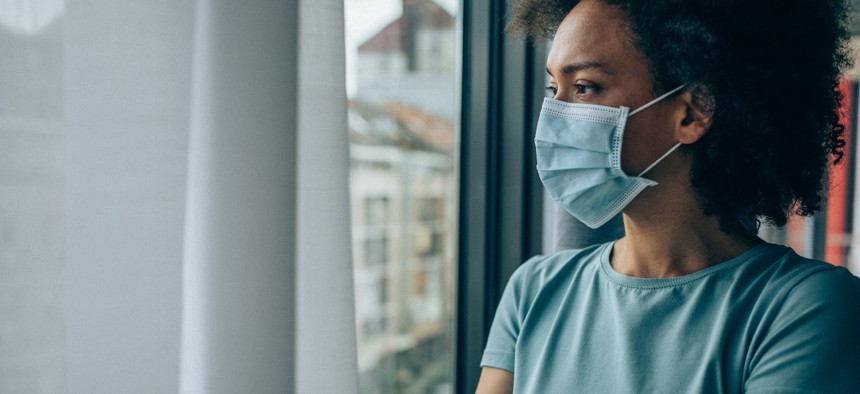
VioletaStoimenova / Getty Images
Coronavirus Roundup: A New Calculator Helps You Figure Out What to Do After a COVID-19 Exposure
There’s a lot to keep track of. Here’s a list of this week’s news updates and stories you may have missed.
The Centers for Disease Control and Prevention has released a new online calculator to help people determine how long they need to quarantine or isolate themselves if they come in close contact with someone who has COVID-19 or if they contracted the virus. It also helps determine when to get tested and wear a mask; however, the tool should not be used for high-risk groups and settings, said the CDC. Here are some of the other recent headlines from this week you might have missed.
The Food and Drug Administration authorized, and the CDC recommended, a second booster shot of Pfizer/BioNTech or Moderna for individuals 50 and older as well as a fifth dose for certain immunocompromised individuals. “Separately and in addition, based on newly published data, adults who received a primary vaccine and booster dose of Johnson & Johnson’s Janssen COVID-19 vaccine at least 4 months ago may now receive a second booster dose using an mRNA COVID-19 vaccine,” said the CDC.
On Wednesday, the White House launched a new website to house information on vaccines, treatments, testing, masks and travel. During remarks to announce the website on Wednesday, President Biden said “just as we’ve reached the critical turning point in this fight, Congress has to provide the funding America needs to continue to fight COVID-19,” which he and other administration officials have been calling for repeatedly.
Atul Gawande, assistant administrator for global health at the U.S. Agency for International Development, wrote in The Washington Post on Wednesday that Congress’ failure to provide more coronavirus funds “bodes serious trouble for the world.” With the lack of additional funding “we risk not having the tools we need — vaccines, treatments, tests, masks and more — to manage future surges at home,” he wrote. “And no less troubling, if we don’t close the vaccine gap between richer and poorer countries, we will give the virus more chances to mutate into a new variant.”
Senate negotiators reached “an agreement in principle” on Thursday for more COVID-19 funding, which is a $10 billion proposal, down about $5 billion from talks earlier in the week, NBC News reported. The White House initially requested $22.5 billion for the supplemental that was stripped out of the fiscal 2022 appropriations package.
When asked about this during the briefing on Thursday, White House Communications Director Kate Bedingfield said there are ongoing talks and the White House is “certainly not going to negotiate from the podium.” However, “I will say that the president has been very clear that there's an urgent need for this funding, and we're very hopeful that Congress is going to come to a solution on this.”
The Special Inspector General for Pandemic Recovery office entered into another partnership with a U.S. Attorney’s Office to further address pandemic fraud. This new one is with the Western District of Virginia.
A new Government Accountability Office report looks at the Health and Human Services Department’s $265 million coronavirus public education campaign in summer 2020, about which congressional Democrats raised concerns. “In the course of our work, we became aware of a potential pre-existing business relationship between an [Office of the Assistant Secretary for Public Affairs] official involved in the public education campaign and one of the suggested subcontractors,” said a footnote in the report. “We have referred this matter to the Offices of Inspector General at HHS and the Department of Justice for action they deem appropriate.”
Another recent GAO report outlines how the Indian Health Service used the more than $9 billion in COVID-19 relief funding it received and how it responded to the pandemic. Funding has been used to “address both immediate and longstanding needs,” such as “replacing an obsolete electronic health records system, implementing a clinical video telehealth system, and funding dozens of sanitation and potable water projects,” said GAO. Despite the Indian Health Service’s prioritization of telehealth, patients’ lack of internet access and equipment was a challenge for hospitals, GAO found. Additionally, the health service “took steps to mitigate workforce, supply and facility challenges to its COVID-19 response through coordination with partners, policy changes, and adjustments to care delivery.”
CIA Director William Burns, who is fully vaccinated and boosted, tested positive for COVID-19 on Thursday morning and is experiencing mild symptoms. His interaction with President Biden was “not considered close contact as defined by CDC guidance, said the agency in a statement.
Help us understand the situation better. Are you a federal employee, contractor or military member with information, concerns, etc. about how your agency is handling the coronavirus? Email us at newstips@govexec.com.







